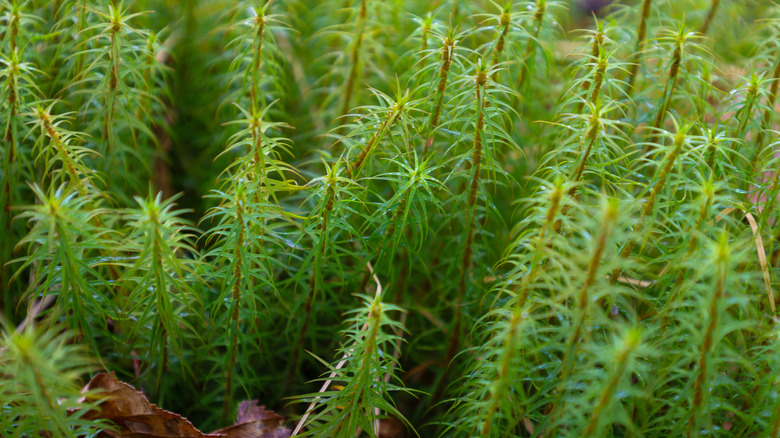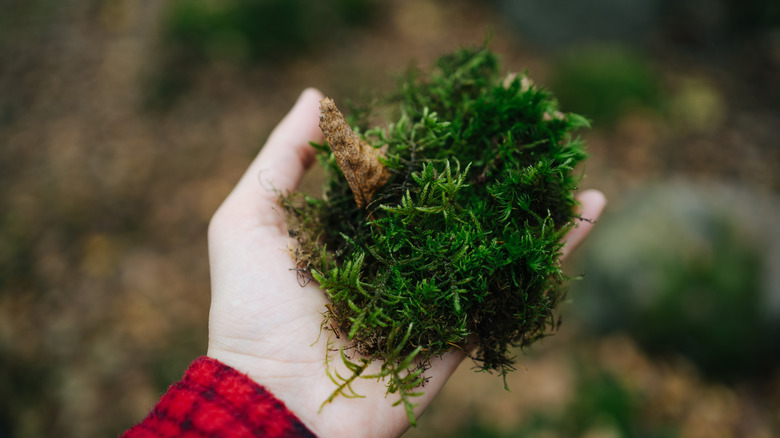Not All Moss Is The Same, Choose The Right One For Your Yard's Needs
Moss is proof that beauty really is in the eye of the beholder. Some gardeners are more concerned with how to get rid of moss, seeing it as an unsightly nuisance in the same category as mold. Other gardeners adore the look of a moss-covered expanse. But these different opinions are also due to how versatile moss is — it can grow pretty much anywhere, and there are thousands of different kinds with different appearances, each of which can serve a different purpose in the garden.
Unlike other plants, mosses have no roots or vascular systems, only leaves and stems. Their resilience means they can survive even in hostile or extreme conditions, making them an essential part of ecosystems all over the world. Mosses have many benefits for home gardeners as well, aside from their subjective beauty. They suppress weed growth while supporting the growth of other plants by boosting humidity and regulating soil temperature. They increase biodiversity, creating "microhabitats" of insects and other tiny organisms. Mosses don't ask for much from humans in return for these boons: no mowing or fertilizing is needed, and they are resilient to heat, cold, drought, disease, and pests all on their own. The leaves stay green all year round.
With more than 20,000 species of moss worldwide — they're the most diverse group of plants aside from flowering ones. These species can be divided into two basic categories: Clumping mosses and spreading mosses. Clumpers grow upright in cushion-like mats, making them ideal for accents or growing between pavers. Spreaders grow in feathery carpets, working well as ground covers or to fill in bare patches of lawn.
Moss species to consider
The most popular moss for gardens is a spreading moss called sheet moss (Hypnum curvifolium). In addition to forming a lush green lawn that's easy to care for, this moss will grow alongside logs, trees, or walls for a fairytale-like look. It can withstand foot traffic and grows best in shady, moist areas, making it ideal for bare areas where grass won't grow. The term "sheet moss" is also used as a term for all species in the Hypnum genus — lots of common names for mosses overlap, so it's best to go by the scientific name when shopping.
Other spreading mosses work well as ground covers, like foxtail moss (Brachythecium rutabulum) or fern moss (Thuidium delicatulum), which looks like tiny ferns and thrives along water features. Both of these also require damp shade. For sunny spots, look at mosses in the Bryum genus, such as sun moss (Bryum caespiticium) or silver moss (Bryum argenteum). They withstand sunshine and work well as a lawn alternative or between pavers.
For clumping mosses, one popular option is cushion moss, which can refer to any species in the Leucobryum genus, such as Leucobryum glaucum. It grows in mounds that are dense, soft, and vividly colored. Another option with a similar appearance is rock cap moss, or the Dicranum genus. There's also haircap moss (Polytrichum spp.). Polytrichum strictum can withstand full sun as long as it's established in moist, clay soil. It can't withstand foot traffic, however. One last type of moss to consider is sphagnum moss, most famous for forming peat bogs and as a common component in potting mixes.
Choosing and growing a moss
When choosing a moss, first identify if any areas of your garden can provide the shade and moisture that most mosses need. For example, if you're considering a moss lawn, the bare patches on your current lawn may help define the shadiest areas where moss could thrive (there may be moss growing there already). If there are no shady enough areas, that helps you narrow your options down to mosses that tolerate full sun. Moisture is more of a non-negotiable, but unless conditions are extremely dry, chances are your mosses can get the water they need from the rain, mist, and dew. Mature mosses only need watering during major droughts; they can also go dormant and come back when moisture is available.
Also consider your garden design and where moss might complement your other plantings. While some mosses can tolerate foot traffic, it's best to install pathways if you'll be walking over the area regularly. You might also want to ensure that you can see the moss from any seating areas.
Live moss is available to buy online or in gardening stores. Alternatively, you can gather moss from outdoors and transplant it into your garden, but check to see if you live in a protected area first. Another option is to grow moss from spores (store-bought or harvested). This process takes a few months and requires using a moist substrate. Moss prefers acidic soil with a pH between 4.5 and 5.5. After the moss has been placed in your garden, you will need to anchor it in place, keep it moist, and regularly remove weeds until it gets established.


